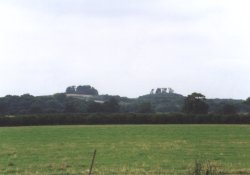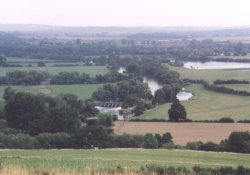

|
Cruising the river towards Dorchester and Day's Lock provides a magnificent view of two hills topped by clumps of trees. These are the Sinodun Hills known usually as the Wittenham Clumps and less respectfully as the Berkshire Bubs or even as Mother Dunch's Buttocks. The unfortunate Mother Dunch was the wife of a less than popular local Medieval squire. |
 |
Castle Hill is to the left, with Round Hill to the right. |
 |
Geologically the Sinodun Hills are an outcrop of the chalk deposits which form the Chiltern Hills, but historically their importance dates back to Iron age Britain. Obviously because of the lack of written evidence much of what is claimed is conjecture. Opinion is divided as to whether they were of religious or military importance. However it is believed that the Atrebati, an ancient tribe of Britain used a fort on Castle Hill to defend themselves against the mighty Roman army of Julius Caesar. Certainly it seems a reasonable interpretation as Castle Hill is surrounded by a deep ditch and ramparts and it affords a splendid view over the surrounding countryside. |
|
Today the Wittenham Clumps are part of the Little Wittenham Nature Reserve managed since the 1980s by the Northmoor Trust. Their role is to create an area devoted to wildlife conservation, public access and education. At present they are involved in a tree planting scheme to replace the beeches which were planted on the twin summits in the 18th century. For various reasons the Clumps have suffered extensive tree loss. The re-planting scheme hopefully will restore the clumps to their former glory. |
 |
They certainly inspired Joseph Tubbs who in 1844 carved the following poem on the Poem Tree. Sadly this tree is now dead but the poem can be read on a plaque on Castle Hill. | |
|
"As up the hill with labr'ing steps we tread Where the twin Clumps their sheltering branches spread The summit gain'd, at ease reclining lay and all around the wide spread scene survey Point out each object and instructive tell The various changes that the land befel. Where the low bank the country wide surrounds That ancient earthwork form'd old Murcia's bounds. In misty distance see the barrow heave, There lies forgotten lonely Culchelm's grave. Around this hill the ruthless Danes intrenched, and these fair plains with gory slaughter drench'd, While at our feet where stands that stately tower In days gone by uprose the Roman power And yonder, there where Thames smooth waters glide In later days appeared monastic pride. Within that field where lies the grazing herd Huge walls were found, some coffins disinter'd Such is the course of time, the wreck which fate And awful doom award the earthly great." |
|
|
There are places to moor downstream of Day's Lock in the field near the River Thame, a little stream that leads to Dorchester (See Places to Visit - Dorchester), or in the meadow above the lock. There is a fee for these moorings collected by the farmer. It is possible also to moor on the lock island, again a fee is due, payable to the lockkeeper. Whichever is used they are ideal starting places for a walk to Wittenham Clumps. At the entrance to the Nature Reserve we were fortunate to be able to pick up a brochure which not only gave a possible route to explore the area, but also information about the reserve and the wildlife that could be found there. The climb to the top is quite steep but is worthwhile for the panoramic view over the River and towards Dorchester, as well as fine views of South Oxfordshire, the Chilterns and the Ridgeway and of course the inescapable Didcot Power Station. | |
 |
 |
The view from Day's Lock | The view down to Day's Lock |
Oxford Archaeology is involved in The Wittenhams Landscape Evolution Centre project, a study of the Clumps. Channel Four's Time Team took part in part of their investigation and was broadcast on Channel Four during a Time Team programme at the end of February. Below are links to reports about the archaeology:-
Oxford Archaeology Interim Summary Report.
Oxford Archaeology Update on Archaeological Research .
Time Team Programme Information.
Click here to return to:
| Places to visit |
|---|
Copyright © The Harts